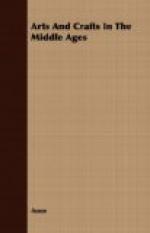This extract is made from a book in one of the early monastic libraries. “Oh, Lord, send the blessing of thy Holy Spirit upon these books, that, cleansing them from all earthly things, they may mercifully enlighten our hearts, and give us true understanding, and grant that by their teaching they may brightly preserve and make a full abundance of good works according to Thy will.” The books were kept in cupboards, with doors; in the Customs of the Augustine Priory of Barnwell, these directions are given: “The press in which the books are kept ought to be lined with wood, that the damp of the walls may not moisten or stain the books. The press should be divided vertically as well as horizontally, by sundry partitions, on which the books may be ranged so as to be separated from one another, for fear they be packed so close as to injure one another, or to delay those who want them.”
We read of the “chained books” of the Middle Ages, and I think there is a popular belief that this referred to the fact that the Bible was kept in the priest’s hands, and chained so that the people should not be able to read it for themselves and become familiar with every part of it. This, however, is a mistake. It was the books in the libraries which were chained, so that dishonest people should not make way with them! In one Chapter Library, there occurs a denunciation of such thieves, and instructions how to fasten the volumes. It reads as follows: “Since to the great reproach of the Nation, and a greater one to our Holy Religion, the thievish disposition of some who enter libraries to learn no good there, hath made it necessary to secure the sacred volumes themselves with chains (which are better deserved by those ill persons, who have too much learning to be hanged, and too little to be honest), care shall be taken that the chains should neither be too long nor too clumsy, more than the use of them requires: and that the loops whereby




